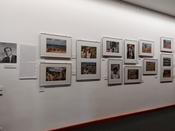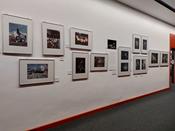John F. Kennedy Institute for North American Studies
Service Navigation
Exhibition: Resilient Colors
After documenting the Great Depression in rural America during the 1930s some of the Farm Security Administration’s (FSA) photographers at the end of the decade embarked on an “experiment”: using color films.
The FSA had been instrumental in organizing the New Deal’s response to the plight of millions of people, mostly tenant farmers and sharecroppers, who in a time of world-economic crisis had been dislocated by three periods of drought – epitomized in the “Dust Bowl” crisis – and the ensuing extensive crop failures, but also by the accelerating mechanization and industrialization of agriculture. They were migrating in the search for work and a new life; 3.5 million of them migrated to California to become migrant day laborers who moved from crop to crop, for almost the whole year. The photographers of the FSA – among others, Dorothea Lange, Walker Evans, Ben Shan, Arthur Rothstein, Carl Mydans – documented the fate of these people, their ordeal, and the relief measures. The leader of the FSA’s documentation effort, Roy Stryker, distributed these images to illustrated magazines and newspapers and supported their publication in form of photo books – as in American Exodus by Dorothea Lange and Paul Taylor – to make the American public aware of the extent of this crisis and to bolster the legitimacy of the New Deal relief and reform measures.
After the introduction of the first film using three colors in 1935 it took Kodak three more years to create reliable processing results and stable colors, so that it could be used for archival and documentary purposes. Kodak provided the FSA with this new film to make “experimental” use of it. When the FSA photography program was absorbed by the Office of War Information (OWI) in 1943 Kodachrome color film had already begun to be routinely used – as is exemplified in the many, quite striking photographs of women working in the war.
The photographs exhibited here have been taken by Marion Post Wolcott, Jack Delano, and Russell Lee. Their color images depict – at least in part – what they used to photograph in B/W: work scenes, living conditions, housing situations. But they added new dimensions to their color photography: gatherings not related to work, leisure activities, celebrations, scenes of calmness and relaxation. It is as if there has been a moment between crises which belonged to a different scale of time. The next crisis, even more daunting, would be WWII. Some photos exhibited have been taken after the Japanese attack on Pearl Harbor, but even the images of the American railroads, taken by Jack Delano, omit a direct reference to the war – in contrast to the OWI’s documentation of the war industry.
Sources:
Library of Congress
Combined FSA/OWI collection of B/W photos: 171,000
Combined FSA/OWI collection of color photos: 1,615
produced by the FSA: 1,155
produced by the OWI: 460



